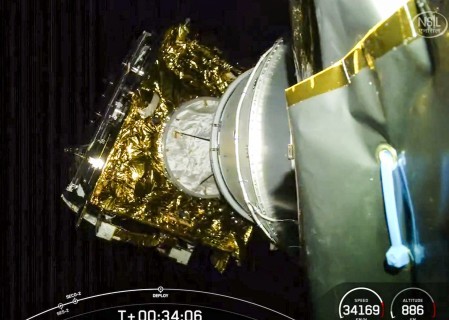BENGALURU (PTI): ISRO on Thursday said it has achieved a major milestone after its CE20 cryogenic engine passed a critical test in ambient condition, featuring restart enabling systems.
According to ISRO, this success was a vital step for future missions.
"ISRO has successfully carried out the sea level hot test of its CE20 Cryogenic Engine featuring a nozzle area ratio of 100 at ISRO Propulsion Complex, Mahendragiri, Tamil Nadu on November 29," the Indian space agency said in a statement.
The indigenous CE20 cryogenic engine developed by the Liquid Propulsion Systems Centre is powering the upper stage of the Launch Vehicle Mark-3 (LVM-3) and has been qualified to operate at a thrust level of 19 tonne, ISRO explained.
It said that this engine has successfully powered the upper stage of six LVM3 missions so far.
"Recently, the engine was qualified for the Gaganyaan mission with a thrust level of 20 tonne and also to an uprated thrust level of 22 tonne for the future C32 stage, towards enhancing the payload capability of LVM3 launch vehicle," ISRO said.
Gaganyaan is ISRO’s first manned mission.
According to the space agency, the performance of a multi-element igniter that is required for engine restart capability was also demonstrated during this test.
"Testing the CE20 engine at sea level poses considerable challenges, primarily due to the high area ratio nozzle which has an exit pressure of approximately 50 mbar," it said.
Millibar is a unit to measure atmospheric pressure and is commonly used in meteorology.
ISRO said that the main concern during testing at sea level included flow separation inside the nozzle, which leads to severe vibrations and thermal problems at the flow separation plane leading to possible mechanical damage of the nozzle.
In order to mitigate this issue, the flight acceptance tests for CE20 engines are currently being performed at the High-Altitude Test (HAT) facility, thereby adding complexity to the acceptance testing procedure, it added.
"To reduce the complexity related to the testing at HAT, a sea level test utilising an innovative ‘Nozzle Protection System’ was devised that has paved the way for a cost-effective and less complex procedure for acceptance testing of the cryogenic engines," the space agency explained.
According to it, restarting a cryogenic engine is a complex process and the major challenges are vacuum ignition without nozzle closure and use of multi-element igniter.
"ISRO has demonstrated vacuum ignition of CE20 engine without nozzle closure in earlier ground tests. In this test, the multi-element igniter performance was also evaluated, wherein only the first element was activated, while the health of the other two elements was monitored," the statement said.
ISRO's CE20 cryogenic engine passes critical test featuring restart enabling system
Article Posted on : - Dec 13, 2024
Other Related News
From MiG-21 to Mirage to Rafale jets: A look at India's key fighter aircraft acquisitions
From opting for the Russian Mikoyan-Gurevich Design Bureau-made MiG-21 in 1961 to receiving the first batch of five French-manufactured Rafale multi-role combat jets on Wednesday, India has come a long way in boosting its air-strike prowess.
 Previous Article
Previous Article Next Article
Next Article













The Indian Air Force, in its flight trials evaluation report submitted before the Defence Ministry l..
view articleAn insight into the Medium Multi-Role Combat Aircraft competition...
view articleSky enthusiasts can now spot the International Space Station (ISS) commanded by Indian-American astr..
view article